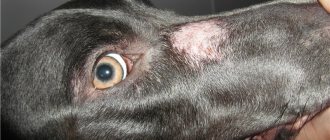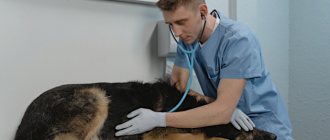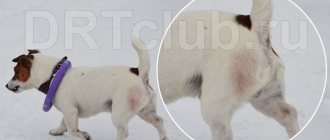How serious and dangerous is it when a dog has bloody stool? If there is fresh blood in the stool, this indicates bleeding from the lower gastrointestinal tract. But not only profuse red blood is a dangerous condition. The appearance of the slightest streaks of blood and black, tarry stool should alert the owner, otherwise it could cost the dog’s life.
Causes of the disease
How can you understand why a dog poops blood? Bleeding can develop as a result of injury or serious illness.
Types of diseases leading to bleeding in dogs:
- tumor;
- infectious;
- exchange;
- somatic.
There are 3 types of blood in a dog’s stool:
- scarlet blood in large quantities;
- streaks of blood;
- tarry liquid stool.
- white chair
List of diseases accompanied by bleeding in dogs:
- haemorrhoids;
- constipation, formation of anal fissures;
- infectious, toxic gastroenteritis;
- space-occupying formations in the stomach and intestines at any level, helminthiases;
- ulcers in the stomach, duodenum (duodenum);
- pancreatitis in a dog.
First aid
As already mentioned, if a pet has loose stools with blood, it must be kept on a fast for 24 hours. On the second day, you can give rice water and a little kefir.
On the third day, you can give a little lean broth, boiled rice or boiled chicken.
This diet should be followed for about a week. This will help the digestive system recover.
NOTE!
During the entire recovery period, do not give your toy terrier fatty or heavy food!
Medicines that can be given to a dog as first aid:
- Activated carbon;
- herbal decoctions with an “astringent” effect (pomegranate peels, serpentine, blueberries);
- Smecta. The medicine perfectly removes toxins and normalizes intestinal function;
- Lactobifadol to normalize intestinal microflora;
- No-spa to reduce spasms and relieve pain.
Symptoms of the disease
The appearance of blood from your pet's anus can indicate various diseases. Therefore, it is important to know the main symptoms of this disease.
Typically, dog poop is light or dark brown in color. If blood impurities appear in them, this is very serious and indicates failures or internal damage. Thus, bright scarlet veins may indicate damage to the large intestine, in particular in the rectum.
If blood discharge changes the color of the stool to dark, almost black, then one can judge that there is a disorder in the upper gastrointestinal tract.
It happens, although rarely, that an animal develops diarrhea mixed with blood. This may indicate severe poisoning or serious problems with the gastrointestinal tract.
What to do?
It is quite clear that if you discover blood impurities in your pet’s stool, you should immediately show him to the veterinarian. In this case, you should not show independence. But the faster you do this, the more chances he will have to recover.
If you cannot do this right away, then first of all, provide your pet with rest and apply a cold compress to the abdomen and sacrum. Under no circumstances should you feed him, give him a laxative, or give him an enema!
The appearance of blood in the stool almost always indicates the seriousness of the illness, the real cause of which can only be determined by a veterinarian after performing the necessary examinations. For the dog owner, only an auxiliary function remains. For example, therapy for rectal bleeding involves a high-quality and balanced diet, timely examinations by a specialist and monitoring the nature of bowel movements.
Show care and attention to your pet, record all deviations in their health, then it will be easier to treat them for various diseases. And some of them will not be able to appear at all.
Stages of senile dementia
The progression of thought disorders occurs gradually. There are several periods (stages) that accompany dementia. The following stages of senile dementia are distinguished:
- At the first stage, mild manifestations of signs of degenerative processes are noticeable. Moderate memory impairment occurs. At the same time, the patient can take care of himself, basic types of household activities (cooking, personal hygiene, cleaning) are available to him. The patient retains critical thinking, he is aware of the presence of the disease and is ready for treatment;
- When dementia develops to the second stage, the patient exhibits more severe impairments of memory and intelligence, critical thinking decreases, and the person ceases to realize that he is sick. Difficulties arise when using the telephone, household appliances, a person forgets to turn off the water or gas. At this stage, the patient requires constant supervision, as he may cause harm to himself or his home;
- The third stage is characterized by a strong progression of dementia, in which a complete collapse of the personality occurs. In the last stage of dementia, the ability to think logically is lost. The patient plunges into complete apathy. Such patients require round-the-clock monitoring and care.
Examination and diagnosis
Determining the severity of the disease in an animal and its severity involves a number of examinations:
- visual inspection of the dog;
- stool examination;
- examination of the rectum;
- ultrasound diagnostics of the peritoneum;
- performing a colonoscopy or gastroscopy (depending on the color of the blood impurity).
For a correct diagnosis, the information that is required from the dog owner also matters a lot:
- timing of the onset of symptoms of the disease;
- whether deworming was carried out in a timely manner and when;
- what kind of diet does the pet have (does it chew bones, picks up food or other objects from the ground);
- does he suffer from loss of appetite, etc.
Based on all this, a diagnosis is established, and a treatment regimen is determined accordingly. Elimination of blood from stool is possible only if the root cause that caused such a symptom is cured. Therefore, do not delay your visit to the veterinary clinic with your four-legged friend. Not only his health, but possibly his life will depend on the speed of your actions.
Hemorrhoidal bleeding
In adult dogs, varicose hemorrhoids develop as a consequence of labor and regular constipation. When these nodules are injured by hard feces, intense bleeding develops. In this case, the feces are intensely stained with fresh blood due to its large amount. Blood loss is regular, significant and leads to anemia. A dog's feces with blood scare everyone, but the bleeding stops on its own. It is necessary to urgently seek help from a veterinary hospital to prescribe adequate therapy and eliminate the risk of recurrent hemorrhage.
In case of rectal prolapse, the diagnosis is not difficult, since the defect is visible to the naked eye. When prolapsed, the intestine is visible from the anus, is easily injured, and bleeds slightly. Most often it is a complication of constipation and bladder stones. Immediate contact with a veterinarian is necessary, because the intestinal wall may be pinched, blood flow stops, and necrosis develops. This situation requires emergency surgery.
Infectious, toxic gastroenteritis
The mechanism of development of gastroenteritis with bleeding is the same during infection or damage to the gastrointestinal tract and is explained by the release of toxic products into the intestinal lumen. It often develops in puppies when they are improperly kept in a cold room or improperly fed, which lead to a decrease in immunity.
When an infectious agent or endogenous toxins is attached, for example against the background of pyelonephritis, the mucous membrane of the gastrointestinal tract becomes edematous. Exposure to food masses, gastric juice, and pancreatic enzymes injures the delicate mucous membrane, and the dog poops blood. The severity of bleeding varies. The less pronounced the bleeding, the more dangerous it is for the dog, since it does not get to the veterinarian sooner, but only after complications develop.
As the disease progresses, the dog develops diarrhea with blood. She refuses to eat, becomes lethargic and apathetic, hides in secluded places, and periodically moans. If a dog has diarrhea with blood, then I should treat it myself; I need to urgently consult a doctor, undergo a full examination aimed at finding the source of bleeding, the cause of the disease, and select individual therapy and diet.
Tumors of the gastrointestinal tract, helminthiases
With a long-term oncological disease of the gastrointestinal tract, the tumor growing into the lumen of the organs is constantly injured by feces and gradually begins to bleed. The severity of bleeding varies. It must be remembered that blood in the stool may not be visible to the naked eye. Hidden bleeding is also dangerous for the body, as it indicates a serious pathology. Therefore, it is necessary to undergo preventive examinations by a veterinarian.
If a dog poops blood due to tumor diseases, then it is too late to ask the question of what to do. Regular examination of the dog by a veterinarian is necessary, which will allow diagnosing the disease at an early stage and preventing its progression and the development of complications. Helminthic infestation - eimeriosis develops more often in puppies at the age of 2-3 months, leading to the appearance of blood streaks in the stool.
Ulcers are the cause of bleeding
Ulceration in the stomach and duodenum with a complicated course leads to bleeding. Intense ulcerative bleeding from the stomach is accompanied by bloody vomiting. But blood loss of about 200 ml will not cause vomiting. A transformation of the blood occurs as a result of the work of enzymes and intestinal bacteria, and the dog develops tarry black liquid or mushy sticky feces. In this situation, immediate consultation with a doctor is necessary.
Loose stools with blood in a dog: Prevention
It is easier to prevent the disease from occurring than to treat the dog later.
Let's talk about preventive measures to combat bloody diarrhea:
- Avoid eating foreign objects. For example, instead of a plastic duck, offer your dog to play with a toy made of durable rubber - Kong .
- Feed high-quality food from trusted sources.
- Carry out preventive treatment against parasites every quarter. Moreover, it is recommended to treat fleas every 1-3 months, since they are carriers of dipylidia (cucumber tapeworm). Drugs for endoparasites: Helmintal , Inspector , Cestal , Milprazone , Drontal , Milbemax, Kanikvantel, Cestal, Endogard, Prasitel, Procox .
- Annual vaccination against viral infections. Vaccines against parvovirus enteritis: Nobivak, Kanigen, Eurikan, Vanguard 7, Vanguard 5 plus . The latter also protects against coronavirus.
- It is recommended that animals be examined once a year: blood tests, urine tests, feces tests, and an ultrasound scan of the abdominal cavity.
- Avoid self-medication without the advice of a veterinarian.
Kong Dog Toys
Treatment
The following basic activities are required:
- If possible, eliminate the causes of the disease.
- Hemostatic agents.
- Replenishment of circulating blood volume.
- Detoxification therapy.
- Maintains liver and kidney function.
- Prevent your dog from eating feces.
- Antibacterial, anti-inflammatory drugs according to indications.
- Compliance with diet.
- Local treatment in the form of enemas, gastric lavages, if prescribed by a veterinarian.
Prevention after recovery consists of regular examinations by a veterinarian, preventive vaccinations, anthelmintics, and proper nutrition to avoid relapses.
Currently reading:
- What to do if your dog vomits blood
- Is it worth it or not to include natural food in your dog’s diet?
- 13 Causes of Indigestion and Diarrhea in Dogs
- 8 ways to treat papillomas on a dog’s body
When is a visit to the vet necessary?
Be sure to take your toy terrier to the vet if:
- an intestinal disorder in a dog does not go away within 1-2 days of home treatment;
- the animal’s condition worsens and the diarrhea intensifies;
- if the disorder is accompanied by lethargy, high fever, vomiting, cough, discharge from the nose and eyes, etc.
Senile dementia: prognosis
With the development of senile dementia, the prognosis will be disappointing. The process is constantly progressing and it is impossible to say exactly when the patient will reach the last stage. Everything is very individual and can take years or months. The patient may reach complete extinction 5-10 years after the onset of the disease.
Patients with senile dementia usually die from diseases that occur in parallel, against the background of complete physical and mental exhaustion. Therefore, to prolong the life of patients and alleviate their condition, doctors at the Yusupov Hospital also treat concomitant diseases.
Disability group
The appendix to the rules on recognizing a person as disabled includes clause No. 5, where dementia (severe, profound and severe mental retardation) is a disease for which lifelong disability is given no later than two years after the initial determination of disability. The first disability group is issued under certain conditions:
- health problems of the patient with a pronounced degree (IV) of impaired body functions;
- third degree of severity of restrictions on the patient’s categories of life activity: ability to care for oneself;
- mobility abilities;
- communication skills;
- ability to work;
- ability to orient and control behavior;
- learning abilities.
Dementia, multiple sclerosis, Alzheimer's disease and other pathological conditions cause disability. MSE can be carried out not only in the presence of the patient, but also in absentia by decision of the bureau. The examination can be carried out in an inpatient department of a hospital or at home, if the patient’s health condition does not allow it and a certificate from a medical institution is available. In some cases, additional examination is prescribed. When the experts have received all the data, the commission makes a decision on recognition of disability or refuses to recognize disability. When a person is recognized as disabled, he is issued the following documents:
- certificate of disability group;
- a certificate of temporary incapacity for work (if a person works and is on sick leave, a note is made about the decision of the ITU);
- individual rehabilitation program.
To apply for benefits, an extract is required, which is drawn up from the patient’s examination report. Based on the extract, a pension for a disabled person is calculated.
Disability in senile dementia
Patients of working age often turn to a doctor and ask: “Do they give disability for dementia? How to get a group? Does the group depend on the type of dementia? What group of disabilities will there be? To register a disability, you should know certain rules:
- To receive a referral for examination, the patient or his relatives must contact the medical institution at the place of registration or temporary residence. The chief physician of the hospital, after receiving an official written request from the patient or the patient’s relatives, gives a referral to MSA;
- a referral to MSE is given to the patient after receiving a conclusion from various specialists, after conducting studies: fluorography, electrocardiogram, tests (the list of necessary studies will be determined by the attending physician);
- if the disability is registered by the patient’s relatives, they must provide a notarized power of attorney.
The last stage of senile dementia
In the final stages of dementia, activities of daily living are significantly impaired. The patient requires constant supervision. The gradual deterioration of the mental state reaches such a level that patients cease to understand even the most basic phenomena of life around them:
- speech is almost lost,
- cannot eat food on their own,
- do not distinguish edible from inedible,
- stop observing the rules of personal hygiene,
- do not control bowel movements
- spend most of their time in bed.
Characteristic of the last stage of dementia is being in the fetal position: the legs are bent as much as possible at the knees and hip joints, the arms are crossed on the chest. Patients can remain in this position for days. When trying to change posture, they resist (as much as possible) and emit exclamations similar to moans or screams. All bowel movements are performed “on one’s own behalf.” In this state, patients with dementia do not recognize loved ones and do not respond to external stimuli.











